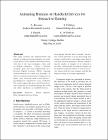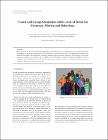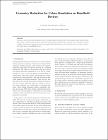Browsing Computer Science by Sponsor "Higher Education Authority"
Now showing items 1-20 of 28
-
3D visualisation of confocal flourescence microscopy data
(2004)Confocal microscopes are able to non-invasively capture sub-micron details of fluorescent-labelled specimens at multiple depths, but there is a lack of applications capable of displaying this collected information in a ... -
Adaptive medial-axis approximation for sphere-tree construction
(2004)Hierarchical object representations play an important role in performing efficient collision handling. Many different geometric primitives have been used to construct these representations, which allow areas of interaction ... -
Animating humans on handlheld devices for interactive gaming
(2005)This paper examines the implementation and efficacy of impostor-based techniques on smallscreen devices, and compares their effectiveness with that of the same techniques when used on desktop computers. Firstly, a ... -
An Approach to Aggregating Ensembles of Lazy Learners that Supports Explanation
(Trinity College Dublin, Department of Computer Science, 2002-04)Ensemble research has shown that the aggregated output of an ensemble of predictors can be more accurate than a single predictor. This is true also for lazy learning systems like Case-Based Reasoning (CBR) and ... -
An Automatically Composable OWL Reasoner for Resource Constrained Devices
(IEEE, 2009)Centralized semantic sensor network systems gradually show performance degradation as the scale of the sensor network increases. Thus systems based on distributed approaches with local, autonomous management features ... -
Computer Graphical Interfaces, Reflection and the Teaching and Learning of Music Composition - a Holistic Study.
(Trinity College Dublin.School of Computer Science and Statistics.COMPUTER SCIENCE, 2006)This thesis is a holistic study in the area of teaching and learning of music composition for children in the age range eight to eleven years. It investigates the role of graphical computer technology within the framework ... -
A context information service using ontology-based queries
(2004)Ubiquitous computing environments have the potential to provide rich sources of information about a user and their surroundings. However, the nature of context information means that it must be gathered in an ad-hoc ... -
Crowd and group simulation with levels of detail for geometry, motion and conversational behaviour
(2002)Work on levels of detail for human simulation has occurred mainly on a geometrical level, either by reducing the numbers of polygons representing a virtual human, or replacing them with a two-dimensional imposter. ... -
Evaluating the visual fidelity of physically based animations
(2003)For many systems that produce physically based animations, plausibility rather than accuracy is acceptable. We consider the problem of evaluating the visual quality of animations in which physical parameters have been ... -
An event model for real-time systems in mobile environments
(IEEE Computer Society, 2004)This paper describes an event model that has been designed to address the predictability requirements of applications operating in mobile environments based on hierarchically structured WAN-of-CANs networks. The event ... -
Exploiting proximity in event-based middleware for collaborative mobile applications
(Springer Berlin / Heidelberg, 2003)Middleware supporting event-based communication is widely recognized as being well suited to mobile applications since it naturally accommodates a dynamically changing population of interacting entities and the dynamic ... -
Fidelity metrics for animation
(2004)In this paper, the problem of evaluating the fidelity of animations will be addressed. Plausible simulation and the perceptual impact of animations generated using approximations or interactive manipulation will be ... -
From Subjects to Concept Clouds - Why semantic mapping is necessary
(2008)To realize the vision of the semantic web it is essential to be able to exchange formal modeled knowledge between applications and humans without loss of meaning. In this paper, we focus on questions relating to meaning, ... -
Geometry reduction for urban simulation on handheld devices
(2005)We present a real-time urban simulation on a Personal Digital Assistant (PDA). An existing desktop urban simulation is used to automatically generate potential visibility data, sub-divide the world into areas of similar ... -
Implementing an Integrated Web-Based Synchronous eLearning Collaboration Platform at Tertiary Level for Part-Time Mature Evening Students
(Trinity College Dublin. Department of Computer Science, 2005-10)This thesis focuses on the lessons learned and new insights gained, from the pilot implementation of a webbased synchronous eLearning collaboration platform at Tertiary Level evaluated on part-time mature evening students. Over ... -
Intuitive Human Governance of Autonomic Pervasive Computing Environments
(IEEE, 2005)This paper proposes an intuitive configuration tool for autonomic pervasive computing systems. Specifically the paper presents a system for the inference of user task intentions from a variety of sensed information and ... -
Levels of detail for crowds and groups
(Blackwell, 2002)Work on levels of detail for human simulation has occurred mainly on a geometrical level, either by reducing the numbers of polygons representing a virtual human, or replacing them with a two-dimensional imposter. ... -
LibViz: Data Visualisation of the Old Library
(2009)The Old Library of Trinity College Dublin, built in 1732, is an internationally renowned research library. In recent decades it has also become a major tourist attraction in Dublin, with the display of the Book of Kells ... -
On the role of ontological semantics in routing contextual knowledge in highly distributed autonomic systems
(Trinity College Dublin, 2006)Much recent research has focused on applying Autonomic Computing principles to achieve constrained self-management in adaptive systems, through self-monitoring and analysis, strategy planning, and self adjustment. ... -
Ontology-based engineering for self-managing communications
(multicon verlag, 2006)Ontology-based semantics support encoding and mapping between separately authored and thus heterogeneous knowledge, and is expressed in widely accepted standards (e.g. W3C?s OWL). It has been suggested that ontology-based ...























